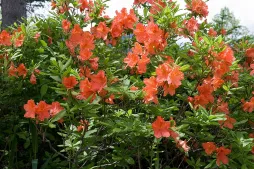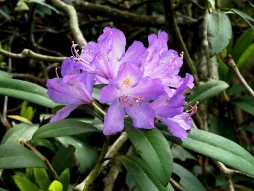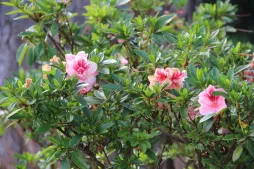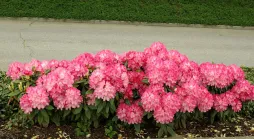Calluna vulgaris, the common heather
The only member of the Calluna genus, Calluna vulgaris grows in the desolate moors of Europe, but also in Morocco. Like winter heather (Erica darleyensis) or erica gracilis (Erica gracilis), common heather belongs to the Ericaceae family. But it is distinguished by its summer flowering, which sometimes earns it the nickname "summer heather".
How to recognize Calluna vulgaris, the common heather?
Calluna vulgaris is a perennial subshrub with a dense, spreading habit. The largest specimens reach a metre in height and 50 centimetres in spread.
The woody stump with its reddish bark supports flexible stems with twisted branches.
The stems are almost entirely covered with four rows of interlocking linear leaves. Scale-like, they measure no more than five millimeters in length. Their color varies according to hybrid and cultivar. Dark green in the botanical variety, they can be white, red or multicolored.
Calluna vulgaris is nicknamed summer heather because of its flowering. From July to the end of September, the plant is adorned with bell-shaped flowers, ranging in color from white to purple and all shades of pink. Highly melliferous, they attract bees, which then produce a thick, dark honey known as heather honey.
Common heather is non-toxic. It poses no danger to us or our pets. The leaves and flowers are even edible!
Our maintenance tips
Common heather are easy-care plants. Once well established, they require almost no care.
Watering
Water when substrate surface is dry. Use non-calcareous water at room temperature. You can use rainwater, for example.
Your Common heather appreciates surface humidity, but hates having its roots immersed in water. After watering, empty any stagnant water from the saucer or planter.
Repotting
Soak the root ball of your Common heather to rehydrate it. Shake the plant to remove excess water.
Get a pierced terracotta pot. You can make a bed of clay balls at the bottom to improve drainage. Mix at least 25% heather soil with ordinary potting compost. Pour on a layer of substrate and plant your Common heather.
Water generously to remove air bubbles and encourage rooting.
Fertilization
To promote the growth of your Calluna vulgaris, apply fertilizer in spring and summer.
Apply a fertilizer for heathland plants every two weeks. Follow the manufacturer's instructions to avoid damaging the foliage.
Prune
You are not obliged to prune your Calluna vulgaris. You can, however, shorten branches with a clean, sharp tool to maintain a compact, rounded habit. Don't cut into old wood: the plant won't recover.
Also remove any spent flowers.
Plantation
When the risk of frost has passed, it's time to plant.
Soak the root ball of your Calluna vulgaris plant. This will help the plant adapt better to its new environment.
Dig a planting hole twice as deep and wider than the root ball to prepare the soil. Common heather likes acidic, well-draining soil. If this is not the case in your garden, mix 2/3 heather soil with 1/3 ordinary potting soil. You can add sand to improve drainage.
Lay down a layer of substrate and plant your Calluna vulgaris. The root ball should be level with the soil. Fill in the planting hole and water generously.
You can also mulch the base with organic matter to keep the soil fresh.
Cutting
Cutting is carried out during the strong growth phase, generally in spring and early summer.
Take a branch about fifteen centimeters long. The stem should be semi-jointed, i.e. Still flexible and not yet woody. Cut below the node closest to the mother stem.
Remove the leaves at the base, keeping only the upper pairs.
Remove the leaves at the base, keeping only the upper pairs.
Prepare a pierced pot of a size suitable for your cutting (about ten centimetres in diameter). Pour a bed of clay marbles into the bottom, followed by a mixture of potting soil for seedlings and cuttings and sand (or perlite). Water generously
Use a pencil or pick to make a pilot hole. Plant your Common heather.
Cuttings root more easily when smothered. Cover the pot with a transparent plastic bag or place it in a mini greenhouse. If you don't have one, a translucent plastic crate will do.
Place in semi-shade and air for a few minutes each day.
Disease / Threat
Information
| Family | Ericaceae - Ericaceae |
| Type | Callune - Calluna |
| Species | Common heather - Calluna vulgaris |
| Lifecycle | Perennial |
| Foliage | Evergreen |
| Exposure | |
| Substrat | |
| Planting methods |
Open ground In pots In tubs Planter |
| Category | |
| Tags |
Beginner Flowery Rustic |
| Origins |
North Africa Northern Europe Eastern Europe Southern Europe Western Europe |
| Hardiness (USDA) | 6b |
| Leaf color |
|
| Flower colors |
|
Discover plants from the same family

Japanese azalea
Discover

Rhododendron ponticum
Discover

Florist's azalea
Discover

Rhododendron yakushimanum
Discover

















